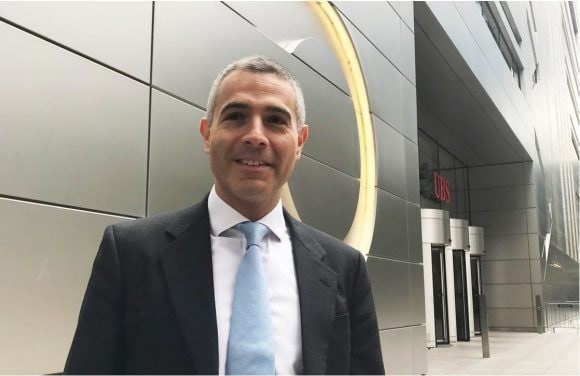Top 10 with…..David Hirst
An interview with David Hirst, Head of REPM's Global Real Estate Sustainability Workgroup on responsible investing in real assets

A proven and global track record
A proven and global track record
The real assets industry is recognizing the importance Environmental, Social and Governance (ESG) factors can have on the environment, society and investment returns. David Hirst, Head of Real Estate & Private Markets' (REPM) Sustainability Workgroup explains to us how the business implements ESG into investment processes and describes some of the key ESG trends driving change in the real assets industry.
Responsible investment facts:
Responsible investment facts:

Rated Green Star by GRESB1

Rated 5-Star by GRESB1

Recycling rate increase2

GHG emission reduction2
What is REPM's attitude towards ESG?
What is REPM's attitude towards ESG?
We believe that there is a direct link between responsible investment and long-term returns. This is why our responsible investment strategy focuses on increasing the value of our investments for our investors and tenants and ensuring that our assets and funds remain secure, resilient and profitable – not only today but in the future. Our strategy takes into consideration long-term resilience, climate change, environmental, social and governance aspects. As a leader in the industry for more than 75 years, we understand that real estate contributes to energy consumption and produces considerable quantities of CO₂ emissions.
Our commitment to sustainability is demonstrated through our investment processes. We have detailed and integrated programs across our portfolios globally to reduce energy and water consumption and reduce and recycle waste in our assets. These strategic objectives benefit investors and tenants, reduces environmental impact and improves the economic aspect of our assets.
In addition, intentional and measurable positive social impact plays a prominent role in our responsible investment strategy. This includes our support in community projects, community development, local education and training, occupier health and wellbeing and the local environment.
Do you have examples of your ESG strategy in action, where results are being achieved?
Do you have examples of your ESG strategy in action, where results are being achieved?
We strive to conduct our business and operate the real assets in our portfolio according to the highest ethical standards by monitoring and evaluating our procedures and policies against best practices.Our sustainability efforts continue to be recognized by the industry, with market-leading performances in the GRESB Assessments in real estate and infrastructure across multiple regions over a number of years. In addition, our business has been consistently achieving top scores in the UN PRI Assessment Report in both Property and Infrastructure modules.1 We've surpassed our five year global goals for reducing the environmental impact of our assets one year ahead of schedule. We reduced energy consumption by 13%, water consumption by 14%, greenhouse gas emissions by 19% and increased the recycling rate to almost 50% over the last five years.
One example is the Post at Pier 52, which is a premier, 208-unit high-rise apartment development in Downtown Seattle’s desirable Pioneer Square neighborhood that earned LEED – NC (New Construction) certification. The Post has been awarded maximum LEED points by the United States Green Building Council as a result of its significant sustainable achievements both in its design and during construction. 75% of construction waste has been recycled, and more than 10% of the building materials are made from locally sourced and recycled material. Other significant green design features include water and energy savings from efficiency systems and improved, healthier air quality.
We're also focusing on the impacts of buildings on human health and wellness. For this reason, we're leading the way in having buildings WELL and Fitwel certified in the US, Netherlands, Spain and the UK.
What is GRESB and how useful is it as an ESG benchmark?
What is GRESB and how useful is it as an ESG benchmark?
GRESB is a third-party organization which assesses the sustainability performance of real asset sector portfolios and assets in public, private and direct sectors worldwide.
Launched in 2009, GRESB has grown to become the leading ESG benchmark for real estate and infrastructure around the world. For example, in 2019 alone, GRESB assessed 1,005 real estate strategies and property companies, 107 infrastructure funds, and 393 infrastructure assets as part of its assessment initiative1.
GRESB offers a range of services, and importantly, its annual Assessments collect information about the sustainability performance of companies, funds and assets, including information on performance indicators such as energy, GHG emissions, water and waste. The Assessment has helped the real asset industry standardize its response to sustainability globally.
As an early adopter of these Assessments, UBS-AM has been contributing data since 2012 across its real estate, infrastructure and real estate debt strategies, securing a total of 93 Green Star ratings and 41 five-star ratings2. These scores represent continued outstanding results at the individual strategy level. This independent recognition of our efforts is incredibly useful given the increasing focus directed by clients and tenants on ESG matters.
How is ESG integrated into your investment process?
How is ESG integrated into your investment process?
We've implemented measures to integrate ESG throughout the entire investment lifecycle. This works to have a positive impact on the long-term risk-adjusted financial returns for our clients. We have objectives at a global level which are incorporated into all of our funds' investment strategies and property operations.
Our sustainability checklist on acquisitions covers: climatic resilience, ecology, social, accessibility, consumption, health, comfort and safety. Our responsible asset management policy sets standards as to how the assets are later developed after acquisition, during management, and even possible long-term re-development. In conjunction with occupiers, we'll consider asset measures that improve the asset's performance. Things such as retrofitting lighting to introduce sensors and LEDs can have a quick impact and save costs.
We've worked with GRESB on a pilot Resilience Report, which provides recommendations for the management of climate risk. The report has identified important areas for action with recommendations to ensure our assets remain resilient against fast-paced climate change.
What are the challenges and opportunities in implementing an ESG investment strategy?
What are the challenges and opportunities in implementing an ESG investment strategy?
Tenant engagement through active ownership is a huge challenge and without it achievements can only ever be limited. Getting an occupier to engage on ESG topics will depend on things like whether it aligns with their own corporate strategy and their own long-term intentions for occupying the asset. Topics such as health and wellbeing, or indoor environmental quality are prominent, while engagement with property managers can help focus conversations around tenant satisfaction, or collecting data as it relates to sustainability performance. Done well, engagement with tenants should provide a transparent report on the property's progress as a whole, and identify areas for improvement while aligning investment priorities and strategies for the long-term to suit both owner and occupier.
Property technology (Proptech) is playing an increasing role in sustainability in all of its aspects: social, environmental, and economic. Investors are looking to make realtime operating decisions about assets based on accurate data that is quickly accessible. This can prove to be a challenge for managers of assets which do not have smart devices to track energy, water consumption, temperature and other related data such as intensity of use. The integration of Proptech not only allows buildings to be more energy efficient, but also saves costs and increases property appeal.
How can ESG impact investor returns?
How can ESG impact investor returns?
There is a historic misconception that investing sustainably will reduce returns. Responsible investment actually aims to add value to an investment by increasing resilience and limiting the risk of regulatory non-compliance or the erosion of its competitive position in the market. Sustainability certifications often increases the appeal of a property to tenants who seek assets which match their own corporate responsibility goals, with the costs of occupation often lower as a result of energy-saving, efficient buildings. Today, we're seeing more and more investors increasingly demand consideration of sustainability when making investment decisions.
How do you measure the impact of ESG for buildings?
How do you measure the impact of ESG for buildings?
There are various global independent organizations committed to assessing the environmental, social and governance performance of assets. Our business participates in them to define specific measures to enhance the performance of assets. They include the UN PRI assessments and the GRESB key performance indicators. In addition, we've obtained building certifications covering energy and health and wellbeing such as BREEAM, LEED, Fitwel and WELL, as well as energy labeling such as EPC and Energy Star.
We aim to set the standard for best practice in sustainable building design, construction and operation using recognized measures of performance to evaluate a range of criteria per building. Nieder-Olm Logistics warehouse complex in Germany is a prime example of how sustainability can be embedded in the development of logistics properties to enhance performance, whilst benefitting investors and the environment. The asset produces 26% less CO₂ compared to the standard value of logistics properties due to its highly efficient heating, ventilation and cooling systems. In addition, it has a 30% energy saving ratio compared to the predefined standards due to its highly efficient insulation capacity.
Another example, the Grossmatte site in Lucerne, houses 164 modern apartments and 2,600 sqm of commercial and working spaces. The building's roof provides 120 kWp of power supply to the site via a solar photovoltaic system.
How is Social Value measured in the context of real estate?
How is Social Value measured in the context of real estate?
Whilst environmental considerations have started to become mainstream in assessing real estate and infrastructure, the 'S' in ESG has been traditionally harder to measure. We recently commenced a pilot to assess the social value of investments. Standing investments – offices, shopping centers, industrial estates – benefit local communities even though it may not be obvious at first sight. We have worked with tenants and our property and facilities management teams onsite to understand and measure things such as local employment levels, traineeships, jobs for young offenders, community events held at the property and volunteering. A third-party collected the data and was able to calculate in monetary terms a social value for the property. The pilot commenced with Springfields Outlet Shopping & Leisure Center in Spalding in the UK. A further six UK and European assets will be piloted, with the aim of having a social value for our portfolio. That social value is the value to the community as well as the financial return to investors. The social value will also be extensively mapped to the UN Sustainable Development Goals.
Is the business doing any work around green bonds?
Is the business doing any work around green bonds?
Green bonds can provide an innovative source of financing which benefits investors and portfolios alike.
In our real estate joint venture with Mitsubishi Corp-UBS Realty Inc. in Japan, we issued the first Green Bond in the Japan J-REIT market in 2018. The Japan Retail Fund Investment Corporation (JRF) issued the five-year bond of JPY 8 billion in 2018 at a lower coupon rate of 0.210%, reflecting a green premium. Following the success of the first Green Bond, JRF issued a second Green Bond in 2019.
The Green Bond framework was independently assessed by Sustainalytics, a global leader in ESG and Corporate Governance research and ratings. The funds raised were used to finance expenditure and acquisitions related specifically to sustainable assets. The relevant assets were assessed according to independent criteria and certifications such as CASBEE and the DBJ Green Building Certification Programme. The Green Bond also provides for reporting by JRF to bond holders on a number of metrics, including consumption data.
What direction do you think ESG, as it relates to property, will take over the coming years?
What direction do you think ESG, as it relates to property, will take over the coming years?
Environmental considerations in running real assets have become mainstream, particularly investors' initiatives towards reducing their carbon footprints. The signing of the Paris climate agreement and the UN Sustainable Development Goals (SDGs) are both clear indicators of the increasing momentum behind ESG globally.
The challenge is to make further and greater energy reductions in line with Paris targets and SDGs. For real asset investment managers, this rests on a consistent implementation across portfolios and asset classes. Over time, we believe that we will see more of a shift towards integrating ESG factors at an even quicker pace as regulation steps up to drive both owners and occupiers to meet ever demanding global targets
David Hirst
David Hirst
Head of REPM's Global Real Estate Sustainability Workgroup
REPM Sustainability Workgroup
Tel +44-207-901 57 83
david.hirst@ubs.com
